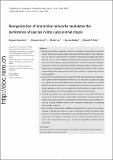Reorganization of interaction networks modulates the persistence of species in late successional stages
Author(s)
del-Val, Ek; Boege, Karina; Rohr, Rudolf P.; Saavedra Sanchez, Serguei; Cenci, Simone
Downloadroh_rin.pdf (330.2Kb)
OPEN_ACCESS_POLICY
Open Access Policy
Creative Commons Attribution-Noncommercial-Share Alike
Terms of use
Metadata
Show full item recordAbstract
Ecological interaction networks constantly reorganize as interspecific interactions change across successional stages and environmental gradients. This reorganization can also be associated with the extent to which species change their preference for types of niches available in their local sites. Despite the pervasiveness of these interaction changes, previous studies have revealed that network reorganizations have a minimal or insignificant effect on global descriptors of network architecture, such as connectance, modularity and nestedness. However, little is known about whether these reorganizations may have an effect on community dynamics and composition. To answer the question above, we study the multi-year dynamics and reorganization of plant–herbivore interaction networks across secondary successional stages of a tropical dry forest. We develop new quantitative tools based on a structural stability approach to estimate the potential impact of network reorganization on species persistence. Then, we investigate whether this impact can explain the likelihood of persistence of herbivore species in the observed communities. We find that resident (early-arriving) herbivore species increase their likelihood of persistence across time and successional stages. Importantly, we demonstrate that, in late successional stages, the reorganization of interactions among resident species has a strong inhibitory effect on the likelihood of persistence of colonizing (late-arriving) herbivores. These findings support earlier predictions suggesting that, in mature communities, changes of species interactions can act as community-control mechanisms (also known as priority effects). Furthermore, our results illustrate that the dynamics and composition of ecological communities cannot be fully understood without attention to their reorganization processes, despite the invariability of global network properties.
Date issued
2017-05Department
Massachusetts Institute of Technology. Department of Civil and Environmental EngineeringJournal
Journal of Animal Ecology
Publisher
Wiley Blackwell
Citation
Saavedra, Serguei et al. “Reorganization of Interaction Networks Modulates the Persistence of Species in Late Successional Stages.” Edited by Elisa Thébault. Journal of Animal Ecology 86, 5 (July 2017): 1136–1146 © 2017 The Authors
Version: Author's final manuscript
ISSN
0021-8790
1365-2656